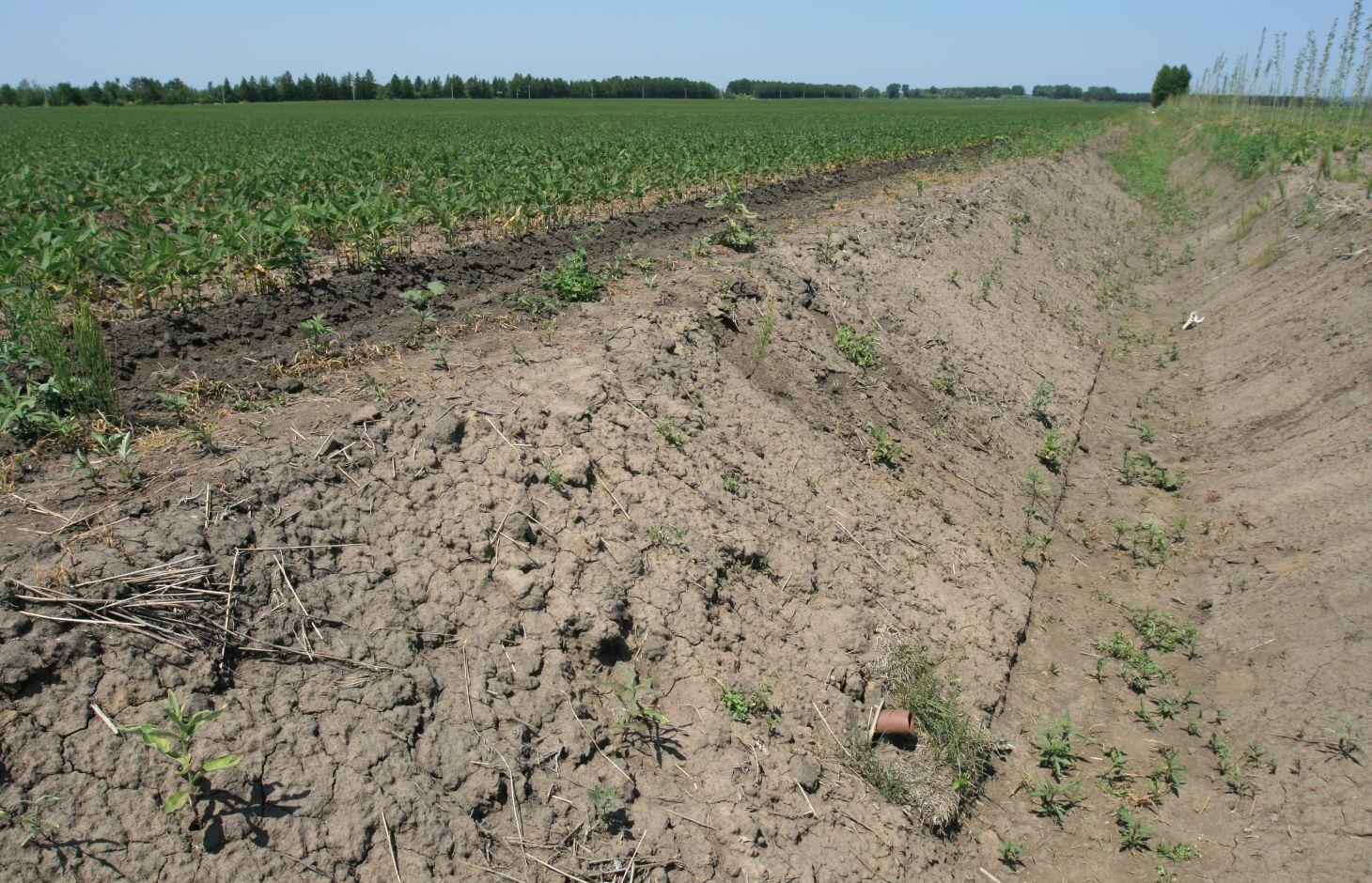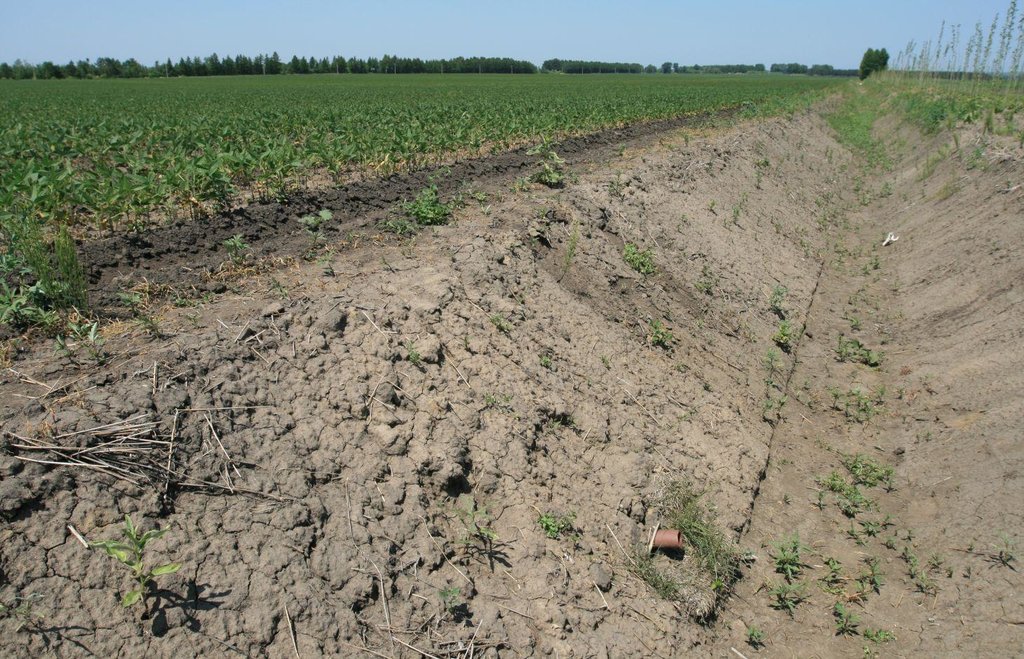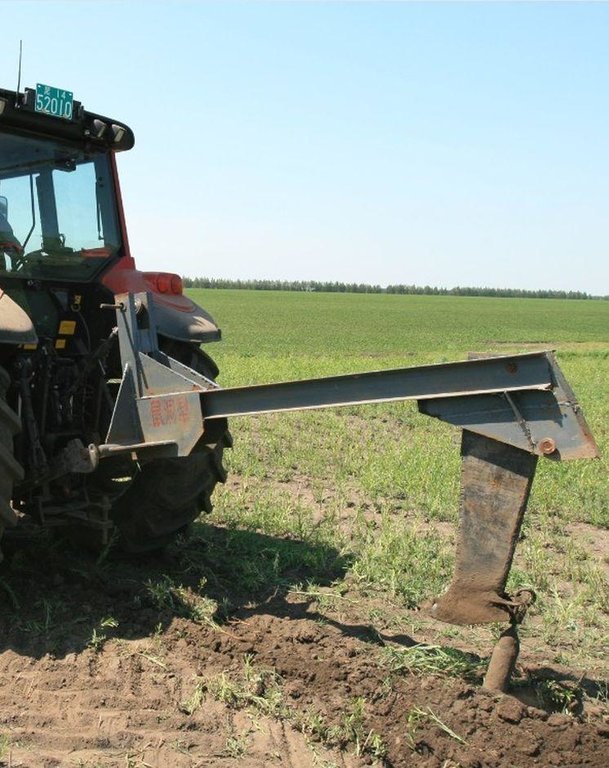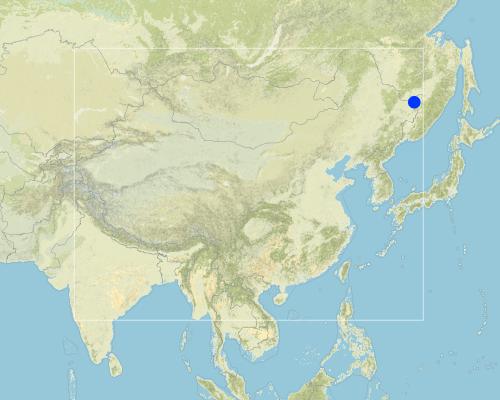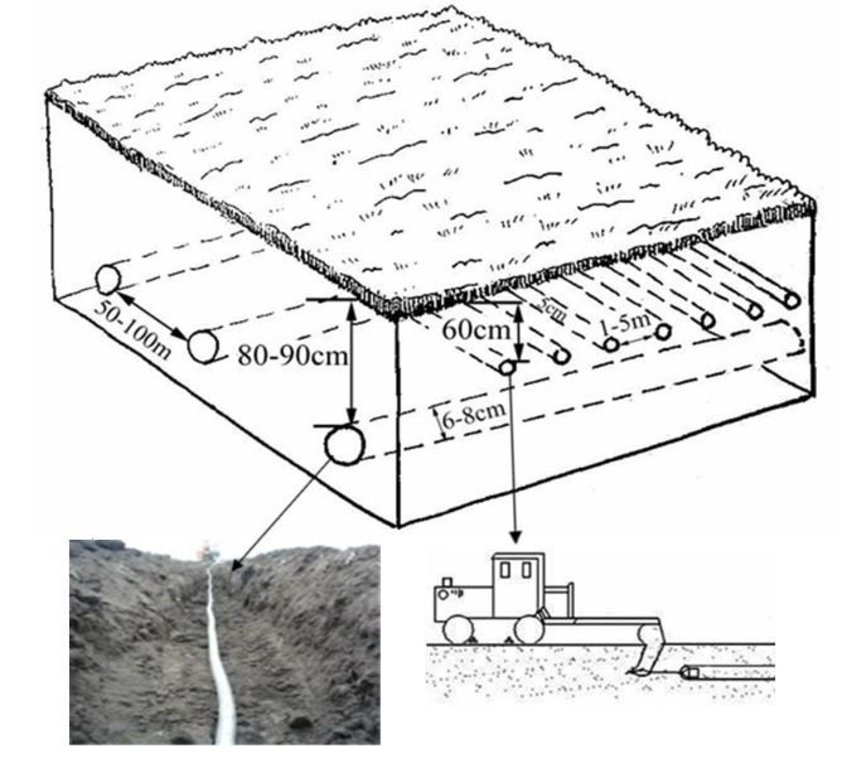Closed Pipe-conduit [China]
- Creation:
- Update:
- Compiler: Mei Zhao
- Editor: –
- Reviewer: Deborah Niggli
Rat tunnel tillage
technologies_1556 - China
View sections
Expand all Collapse all1. General information
1.2 Contact details of resource persons and institutions involved in the assessment and documentation of the Technology
SLM specialist:
Lingqin Meng
Division of water and soil conservation, Songliao water resources commission, ministry of water resources P.R. China
China
Name of the institution(s) which facilitated the documentation/ evaluation of the Technology (if relevant)
Songliao Water Resources Commission (Songliao Water Resources Commission) - China1.3 Conditions regarding the use of data documented through WOCAT
When were the data compiled (in the field)?
28/02/2013
The compiler and key resource person(s) accept the conditions regarding the use of data documented through WOCAT:
Ja
1.4 Declaration on sustainability of the described Technology
Is the Technology described here problematic with regard to land degradation, so that it cannot be declared a sustainable land management technology?
Nee
2. Description of the SLM Technology
2.1 Short description of the Technology
Definition of the Technology:
A Rat tunnel is a kind of subdrainage. It is a drainage duct formed through extrusion or oscillation in soil layer by pulling a mole plough with a tractor. The rat tunnels in a field should be used together with a concealed conduit drainage system in order to safely and quickly drains the water in the rat tunnels and avoid field collapses incurred by poor drainage and washings on the rat tunnels.
2.2 Detailed description of the Technology
Description:
Rat tunnels are suitable for the regions with sticky and heavy soil, thick soil layer, and lower infiltration rates, high underground water level and where waterlogs are very likely to happen. By applying the rat tunnels, infiltration can be increased, soil salinization can be prevented without affecting the growth of the crops and occupying croplands. Good effect can be achieved by combining rat tunnels with closed conduits in application. Closed drainage refers to burying the drain pipes underground and letting the underground water flow along the fissures between the pipes and penetrate into the tubes and drained. In a field, if rat tunnels and closed conduits are combined for use, the rat tunnels constitute the first-grade drainage system, the closed conduits constitute the second-grade drainage system; the stagnant water in the plough layer penetrates through the soil and rat fissures and converges into the rat tunnels; While draining the water inside themselves to the outside, the rat tunnels collect the inside stagnant water and guide the water into the closed conduits, through which the water is discharged. In this way, the surface water can be discharged in a relatively thorough way.
Increase of soil infiltration, rapid discharge of direct surface runoffs, prevention of soil salinization.
In building such a project, the closed conduits should be built first, followed by the building of the rat tunnels; the closed conduits should be under the rat tunnels, the included angle between a closed conduit and a rat tunnel should be 90°.
The gap between two neighboring laid closed conduits should be 50m-100m. The burying depth of a closed conduit should be 80cm-90cm, the area around the closed conduit should be evenly laid with a layer of coarse gravels 5-8cm in thickness. After the project on the closed conduits in a field is accomplished, restore the flatness of the field surface, then undertake the operation on the rat tunnels.
In building the rat tunnels, a tractor is directly applied to pull the mole plough in accordance with the designed distances. When the tractor moves forward, the mole plough goes deep into a specified depth(generally 60cm) of soil layer and generates through piercing the soil along the direction of the forward motion of the tractor a tunnel(rat tunnels) whose diameter is equal to bullet diameter and which is in parallel with the ground surface. The separation distance between two neighboring rat tunnels is 1-5m. The service life is generally 2-5 years. If the rate of flow of a field obviously decreases, new rat tunnels should be built by averting the original routes.
After a rainfall, check whether the rat tunnels have collapsed. The service life of the newly laid closed conduits is over 20, however, new rat tunnels should be built every two years.
Rat tunnels are mainly distributed on the Three River Plain, which is the largest marsh distribution area. It has a total population of about 8.625, with the population density being about 79/km2. With the annual average temperature being 1℃-4℃,being warm in summer with the average temperature being over 22℃, having an annual amount of precipitation of 500-600 mm with the rainfall seasons mainly concentrated in the hot seasons from June to August, the Three River Plain is suitable for the growth of crops. The area is affluent in water resources, with the total quantity reaching about 18.764 billion/m3. In this area, the per capita cultivated land area is about 5 times of the average level in China. There are also about 2.52 millions of theropencedrymion distributed in the terrains with low mountains and hills.
2.3 Photos of the Technology
2.5 Country/ region/ locations where the Technology has been applied and which are covered by this assessment
Country:
China
Region/ State/ Province:
Hei Longjiang
Further specification of location:
San Jiang Plain
Map
×2.6 Date of implementation
If precise year is not known, indicate approximate date:
- 10-50 years ago
2.7 Introduction of the Technology
Specify how the Technology was introduced:
- during experiments/ research
3. Classification of the SLM Technology
3.1 Main purpose(s) of the Technology
- reduce, prevent, restore land degradation
3.2 Current land use type(s) where the Technology is applied

Cropland
- Annual cropping
Comments:
Major land use problems (compiler’s opinion): high underground water level, lower infiltration rates,Soil salinization
Major land use problems (land users’ perception): It's hard to drainage excess water. Lower soil fertility
3.3 Further information about land use
Water supply for the land on which the Technology is applied:
- rainfed
Number of growing seasons per year:
- 1
Specify:
Longest growing period in days: 150, Longest growing period from month to month: From April to September
3.4 SLM group to which the Technology belongs
- water diversion and drainage
3.5 Spread of the Technology
Specify the spread of the Technology:
- evenly spread over an area
If the Technology is evenly spread over an area, indicate approximate area covered:
- > 10,000 km2
Comments:
This technology is widely used in San Jiang Plain.
3.6 SLM measures comprising the Technology

structural measures
- S11: Others
3.7 Main types of land degradation addressed by the Technology

soil erosion by water
- Wt: loss of topsoil/ surface erosion
- Wm: mass movements/ landslides

soil erosion by wind
- Et: loss of topsoil

physical soil deterioration
- Pc: compaction
Comments:
Causes of degradation: soil management (Backward management modes), change of seasonal rainfall (The rainy seasons mainly focus on summer), Heavy / extreme rainfall (intensity/amounts) (The land can't drainge the excess water after downpours), population pressure (Population pressure makes extensive cultivation in this region), land tenure (As the lands are owned by country or by peasant communities, the peasants will not protect their land initiatively.), education, access to knowledge and support services (The channels for the local peasants get knowledge are few, and they will not learn knowledge initiatively.), governance / institutional
3.8 Prevention, reduction, or restoration of land degradation
Specify the goal of the Technology with regard to land degradation:
- restore/ rehabilitate severely degraded land
4. Technical specifications, implementation activities, inputs, and costs
4.1 Technical drawing of the Technology
4.2 Technical specifications/ explanations of technical drawing
Diameter of closed conduit: 6-8cm, separation distance between two neighboring closed conduits: 50-100m, burying depth: 80-90cm: Diameter of rat tunnel: 5cm, separation between two neighboring rat tunnels: 1-5m, depth: 35-100cm(generally being 60cm). If the depth of the rat tunnels is >60cm, the depth of the closed conduit should be adequately increased.
Location: Hong Xing Farm. Hei Longjiang Province
Date: 2012-7-19
Technical knowledge required for field staff / advisors: high
Technical knowledge required for land users: high (It's complicate to constructe this technology)
Main technical functions: increase of infiltration
Secondary technical functions: control of dispersed runoff: retain / trap, control of dispersed runoff: impede / retard, control of concentrated runoff: impede / retard, improvement of surface structure (crusting, sealing), improvement of topsoil structure (compaction), improvement of subsoil structure (hardpan), improvement of water quality, buffering / filtering water
Structural measure: Closed conduit
Vertical interval between structures (m): 0
Spacing between structures (m): 50-100
Depth of ditches/pits/dams (m): 8-9
Width of ditches/pits/dams (m): 0.06-0.08
Length of ditches/pits/dams (m): >50
Structural measure: Rat tunnel
Vertical interval between structures (m): 0
Spacing between structures (m): 1-5
Depth of ditches/pits/dams (m): 6
Width of ditches/pits/dams (m): 0.05
Length of ditches/pits/dams (m): >50
Construction material (other): A closed conduit is a kind of corrugated plastic conduit with the diameter generally being 6-8cm and
Slope (which determines the spacing indicated above): 0%
Lateral gradient along the structure: 0%
4.3 General information regarding the calculation of inputs and costs
other/ national currency (specify):
Ren Min Bi
Indicate exchange rate from USD to local currency (if relevant): 1 USD =:
6.25
Indicate average wage cost of hired labour per day:
60.00
4.4 Establishment activities
| Activity | Type of measure | Timing | |
|---|---|---|---|
| 1. | Layout the line of Closed Conduit | Structural | Spring |
| 2. | Laid closed conduits | Structural | Spring |
| 3. | Build rat tunnels.The tractor is directly applied to pull the mole plough in accordance with the designed distances. | Structural | Spring |
4.5 Costs and inputs needed for establishment
| Specify input | Unit | Quantity | Costs per Unit | Total costs per input | % of costs borne by land users | |
|---|---|---|---|---|---|---|
| Labour | labour | ha | 1.0 | 64.0 | 64.0 | |
| Equipment | first machine | ha | 1.0 | 224.0 | 224.0 | |
| Equipment | second machine | ha | 1.0 | 24.0 | 24.0 | |
| Construction material | corrugated plastic conduit | ha | 1.0 | 640.0 | 640.0 | |
| Total costs for establishment of the Technology | 952.0 | |||||
Comments:
Duration of establishment phase: 1 month(s)
4.6 Maintenance/ recurrent activities
| Activity | Type of measure | Timing/ frequency | |
|---|---|---|---|
| 1. | Build rat tunnels. | Structural | every two years |
4.7 Costs and inputs needed for maintenance/ recurrent activities (per year)
| Specify input | Unit | Quantity | Costs per Unit | Total costs per input | % of costs borne by land users | |
|---|---|---|---|---|---|---|
| Equipment | second machine | ha | 1.0 | 24.0 | 24.0 | |
| Total costs for maintenance of the Technology | 24.0 | |||||
Comments:
Machinery/ tools: Mole Plough, refer to the photo of technical drawing.
The accounted costs for each hectare are as follows: Depth, diameter and spacing on closed conduit: being 90cm, 8cm and 80m respectively, the closed conduits with a total length of 200m are required for each hectare. 1. Costs of closed conduit laying: Tractor cost is 224$US ; Expense of the conduit materials is 640$US; Labor expense is 64$US. 2. Costs of rat tunnel building: Machinery cost: 24$US/hectare (the operation efficiency: 30 hectare/day). No maintenance cost. However, new rate tunnels should be built with the same costs(24$US) every 2 years. The service life of the closed conduits is over 20 years.
4.8 Most important factors affecting the costs
Describe the most determinate factors affecting the costs:
The most determinate factors is the cost of corrugated plastic conduit.
5. Natural and human environment
5.1 Climate
Annual rainfall
- < 250 mm
- 251-500 mm
- 501-750 mm
- 751-1,000 mm
- 1,001-1,500 mm
- 1,501-2,000 mm
- 2,001-3,000 mm
- 3,001-4,000 mm
- > 4,000 mm
Agro-climatic zone
- sub-humid
- semi-arid
Thermal climate class: temperate, boreal
5.2 Topography
Slopes on average:
- flat (0-2%)
- gentle (3-5%)
- moderate (6-10%)
- rolling (11-15%)
- hilly (16-30%)
- steep (31-60%)
- very steep (>60%)
Landforms:
- plateau/plains
- ridges
- mountain slopes
- hill slopes
- footslopes
- valley floors
Altitudinal zone:
- 0-100 m a.s.l.
- 101-500 m a.s.l.
- 501-1,000 m a.s.l.
- 1,001-1,500 m a.s.l.
- 1,501-2,000 m a.s.l.
- 2,001-2,500 m a.s.l.
- 2,501-3,000 m a.s.l.
- 3,001-4,000 m a.s.l.
- > 4,000 m a.s.l.
5.3 Soils
Soil depth on average:
- very shallow (0-20 cm)
- shallow (21-50 cm)
- moderately deep (51-80 cm)
- deep (81-120 cm)
- very deep (> 120 cm)
Soil texture (topsoil):
- medium (loamy, silty)
Topsoil organic matter:
- medium (1-3%)
5.4 Water availability and quality
Ground water table:
5-50 m
Availability of surface water:
excess
Water quality (untreated):
for agricultural use only (irrigation)
5.5 Biodiversity
Species diversity:
- medium
5.6 Characteristics of land users applying the Technology
Market orientation of production system:
- mixed (subsistence/ commercial
- commercial/ market
Off-farm income:
- 10-50% of all income
Relative level of wealth:
- average
- rich
Individuals or groups:
- groups/ community
Level of mechanization:
- manual work
- mechanized/ motorized
Gender:
- men
Indicate other relevant characteristics of the land users:
Land users applying the Technology are mainly common / average land users
Population density: 10-50 persons/km2
Annual population growth: < 0.5%
10% of the land users are very rich.
45% of the land users are rich.
35% of the land users are average wealthy.
10% of the land users are poor.
Off-farm income specification: Apart from farming, the main works of the local people involve doing works for others in cities and towns or doing business.
5.7 Average area of land owned or leased by land users applying the Technology
- < 0.5 ha
- 0.5-1 ha
- 1-2 ha
- 2-5 ha
- 5-15 ha
- 15-50 ha
- 50-100 ha
- 100-500 ha
- 500-1,000 ha
- 1,000-10,000 ha
- > 10,000 ha
Is this considered small-, medium- or large-scale (referring to local context)?
- large-scale
5.8 Land ownership, land use rights, and water use rights
Land ownership:
- state
- communal/ village
Land use rights:
- communal (organized)
Water use rights:
- communal (organized)
Comments:
The lands are owned by country or by peasant communities.
5.9 Access to services and infrastructure
health:
- poor
- moderate
- good
education:
- poor
- moderate
- good
technical assistance:
- poor
- moderate
- good
employment (e.g. off-farm):
- poor
- moderate
- good
markets:
- poor
- moderate
- good
energy:
- poor
- moderate
- good
roads and transport:
- poor
- moderate
- good
drinking water and sanitation:
- poor
- moderate
- good
financial services:
- poor
- moderate
- good
6. Impacts and concluding statements
6.1 On-site impacts the Technology has shown
Socio-economic impacts
Production
fodder production
fodder quality
animal production
wood production
product diversity
production area
Water availability and quality
drinking water availability
Income and costs
farm income
diversity of income sources
economic disparities
workload
Socio-cultural impacts
cultural opportunities
community institutions
national institutions
SLM/ land degradation knowledge
conflict mitigation
situation of socially and economically disadvantaged groups
contribution to human well-being
Comments/ specify:
Local peasants learn some knowledges of soil and water conservation though this technology.
Ecological impacts
Water cycle/ runoff
water quantity
water quality
harvesting/ collection of water
surface runoff
excess water drainage
groundwater table/ aquifer
evaporation
Soil
soil moisture
soil loss
soil crusting/ sealing
salinity
6.2 Off-site impacts the Technology has shown
water availability
reliable and stable stream flows in dry season
downstream flooding
downstream siltation
groundwater/ river pollution
buffering/ filtering capacity
damage on neighbours' fields
damage on public/ private infrastructure
6.3 Exposure and sensitivity of the Technology to gradual climate change and climate-related extremes/ disasters (as perceived by land users)
Gradual climate change
Gradual climate change
| Season | Type of climatic change/ extreme | How does the Technology cope with it? | |
|---|---|---|---|
| annual temperature | increase | well |
Climate-related extremes (disasters)
Meteorological disasters
| How does the Technology cope with it? | |
|---|---|
| local rainstorm | well |
| local windstorm | well |
Climatological disasters
| How does the Technology cope with it? | |
|---|---|
| drought | well |
Hydrological disasters
| How does the Technology cope with it? | |
|---|---|
| general (river) flood | well |
Other climate-related consequences
Other climate-related consequences
| How does the Technology cope with it? | |
|---|---|
| reduced growing period | well |
6.4 Cost-benefit analysis
How do the benefits compare with the establishment costs (from land users’ perspective)?
Short-term returns:
negative
Long-term returns:
slightly positive
How do the benefits compare with the maintenance/ recurrent costs (from land users' perspective)?
Short-term returns:
slightly negative
Long-term returns:
positive
6.5 Adoption of the Technology
- more than 50%
If available, quantify (no. of households and/ or area covered):
95% of all households
Of all those who have adopted the Technology, how many have did so spontaneously, i.e. without receiving any material incentives/ payments?
- 0-10%
Comments:
This technology only be implemented by farmers, because it's too expensive for peasant to afford it. If farmers implement the technology, the local government will organization peasants to help farmers, the government pay for the wages.
A few of land users will implement the technology without any external material support.
There is a little trend towards spontaneous adoption of the Technology
6.7 Strengths/ advantages/ opportunities of the Technology
| Strengths/ advantages/ opportunities in the compiler’s or other key resource person’s view |
|---|
| Fast drainage of surface water |
| Prevention of soil salination |
6.8 Weaknesses/ disadvantages/ risks of the Technology and ways of overcoming them
| Weaknesses/ disadvantages/ risks in the land user’s view | How can they be overcome? |
|---|---|
| New rat tunnels should be built every two years |
| Weaknesses/ disadvantages/ risks in the compiler’s or other key resource person’s view | How can they be overcome? |
|---|---|
| Complicated in construction, big investment | seeking other substitutes |
7. References and links
7.1 Methods/ sources of information
- field visits, field surveys
- interviews with land users
7.2 References to available publications
Title, author, year, ISBN:
Techniques standard for comprehensive control of soil erosion in the black soil region, Author: Shen Bo; Meng Lingqin, Years: 2009
Available from where? Costs?
Internal book
Links and modules
Expand all Collapse allLinks
No links
Modules
No modules


